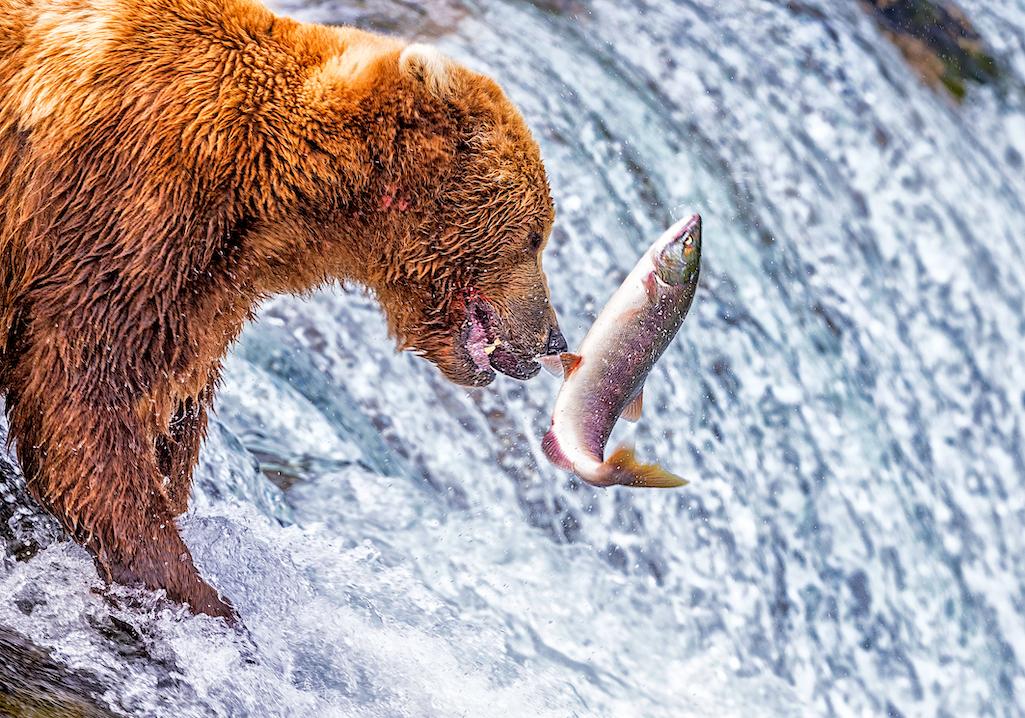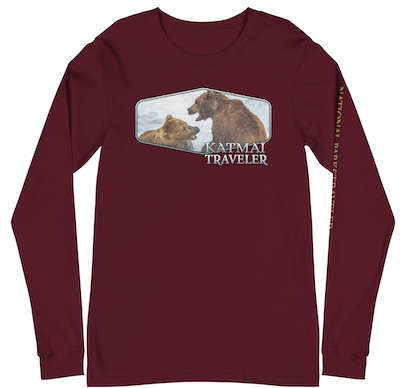
Fat Bear Week is drawing near at Katmai National Park and Preserve in Alaska/Rebecca Latson file
The brown bears at Katmai National Park and Preserve in Alaska sense the change in seasons. Maybe it's the chill in the air, or the salmon run up the Brooks River, but the bears are chowing down on the fish and bulking up for hibernation.
These are no small bears. At times eating up to 40 pounds of sockeye a day, the bears that congregate along the river with its small waterfall can weigh as much as 1,000 pounds. It's no easy task, either, trying to grab a leaping fish out of the air with your jaws, or maybe hanging around in the river's slack water hoping to sweep one up with your paw.
"Here at Katmai, we have one of the densest concentrations of brown bears anywhere in the world, with an estimated population of 2,200 in the park and preserve," Lian Law, the park's visual information specialist, told the Traveler's Lynn Riddick in this week's podcast. "All of our bears here are brown bears. I know there are often questions about the difference between brown bears and grizzly bears, but that distinction is often arbitrary in some ways because they are the same species. That being said, though, brown bears are generally considered those that have access to coastal food resources like salmon, compared to grizzly bears who live more inland."
That fat-rich diet of fish is the game changer when you compare the two bear populations.
"The main difference really is what they are eating, and that in turn kind of affects their size," explained Law. "So in general, because brown bears have access to those coastal food resources, those really fatty resources like salmon, they tend to be a lot larger compared to grizzly bears."
Since 2014 the piling on of pounds by Katmai's bears has spurred perhaps the most unusual competition in the National Park System to see which of the bears along the river will bulk up the most. Rangers create a March-Madness style bracket pitting individual bears against each other. The public then votes to see who will advance each round. Voting takes place over several days on www.fatbearweek.org. People may vote using any criteria they see fit. In the end, one bear will reign supreme.
The competition, which attracted about 800,000 votes last year, was created as a way to educate the public on the park's brown bears and the environment they call home. Supporting the National Park Service in the endeavor are the Katmai Conservancy and explore.org, which livestreams bears fishing in the river. Last year's champion was voted by the virtual audience to be Otis, who became a four-time winner.
Though it revolves around a game, bears take this week (and others in the fall) seriously. According to park wildlife biologists, the bears can down upwards of 40 sockeye salmon per day, with each fish containing about 4,500 calories. The pounds they pack on are needed to get them through their long winter hibernation, when they don't eat or drink and their respiration can fall to one breath a minute with a companion heart rate of 8-19 beats per minute.
While brown bears can be seen throughout the national park, the Brooks River area has gained fame for its high concentration of bears in search of a meal.

Celebrate Fat Bear Week with a Traveler shirt sporting one of Rebecca Latson's photos from Brooks River. They come in a variety of colors, and all profits go to support the National Parks Traveler. Check them out at https://nationalparkstraveler.myshopify.com/
"Brooks Falls in particular is a bit unique, and it's an iconic area," Law told Riddick. "If you ever see pictures of bears catching fish at the lip of a waterfall, that's exactly where we are talking about. And brown bears here are seen in large numbers. I have stood at the falls platform before and counted 60 bears all within one sweeping view. And I think the real question is why do we see so many at this particular location and Brooks Camp as well? And to answer that you kind of have to look at the physical features of the Brooks Falls. So the waterfall itself is only about six feet high, and when you compare that to many other waterfalls in national parks, it's pretty small, it's pretty insignificant.
"However, the fall spans the entire river. And so for salmon looking to migrate upstream, six feet is quite an obstacle," she added. "And so as fish attempt to jump the falls, it creates a backlog of salmon. And often these high concentrations of salmon make for relatively easy fishing. And so that's why we see such large numbers of bears here."
While watching this gluttonous feasting in person is incredible, the use of bear cams staged by Explore.org make it easy to watch the annual chow down from anywhere in the world.
"We have eight bear cams located in the park. A couple at the Brooks Falls area, one downstream of the falls we have an underwater cam, as well as several at the lower river and one on Dumpling Mountain," the ranger said. "We work hand-in-hand with our partner Explore.org. And they have a huge hand in coming out each year and helping things get up and running, and then also coming up in fall to help shut things down. And along with them, we run a lot of live programs on the cameras as well. I think so often we see bears as solitary creatures. And here at Brooks when food is plentiful, we get to see moments where bears interact, not just in competition, but they play as well. So we see cubs playing with each other. Sometimes cubs from different litters playing with each other, and even subadult bears, which are like the teenagers of the bear world, as well as adult bears playing, too."
The bears have developed different approaches to gorge their way towards winter.
"We see all sorts of different fishing techniques that bears use, from a dash-and-ground technique, which is an active one where they're running after the fish, and they'll try and pounce and catch that fish to the ground and get it there," said Law. "Or we'll see more of a sit-and-wait technique, waiting for the fish come to you. And that can be very energy efficient. It's all about more calories in then out. It's incredible to watch these bears fish because there's such dexterity there. And I know I mentioned the lip of the falls earlier. That is a place that not all bears learn to fish. It's really difficult, because when you think about it, you have this five-pound fish flying at your face and you have to be able to catch it in your mouth. So imagine trying to catch a sack of flour being thrown at you. It's so amazing to watch bears pull this off."
Fat Bear Week kicks off on October 5 and runs through October 11. In addition to voting during this week-long tournament, there will be a series of online chats on explore.org featuring Mike Fitz, explore.org's resident naturalist, and rangers from Katmai, according to park staff. "These chats focus on both the individual bears and Katmai's healthy ecosystem," they say.
Schedule of events:
- September 26: Fat Bear Junior Bracket revealed on social media
- September 28: Live Chat at 3 p.m. AK - Bear Language with information about the Fat Bear Junior competitors*
- September 29 – 30: Fat Bear Junior voting open**
- October 3: Live Chat at 3 p.m. AK - Fat Bear Week Bracket Reveal*
- October 4: Premiere of Fat Bear Week in the Classroom chat at 8 a.m. AK*
- October 5: Live Chat at 3 p.m. AK – Welcome to Fat Bear Week*
- October 5 – 11 Fat Bear Week voting open**
- October 11: Live Chat at 3pm AK – Fat Bear Tuesday (end of Fat Bear Week)*
*All live chat events are hosted on explore.org live chat channel.
**All voting takes place at www.fatbearweek.org
Teachers and home-schoolers across the country can use Fat Bear Week as an educational took, with curriculum ideas the park staff has created here.
To hear Lynn's entire conversation with Lian, download this week's podcast.



Add comment